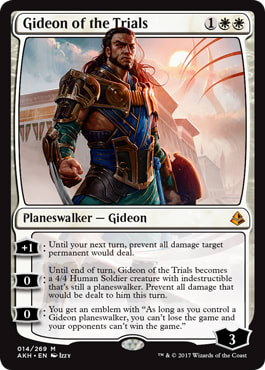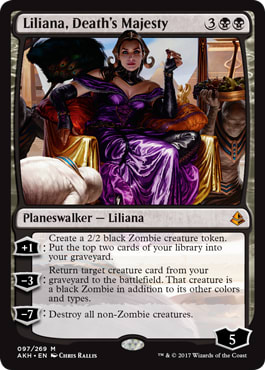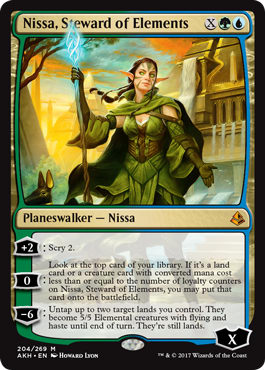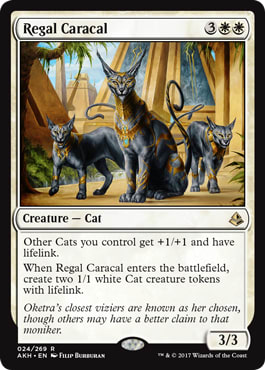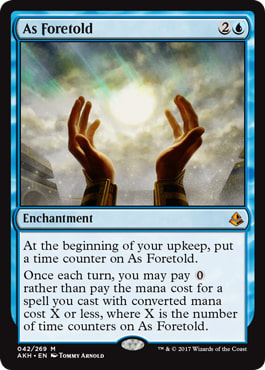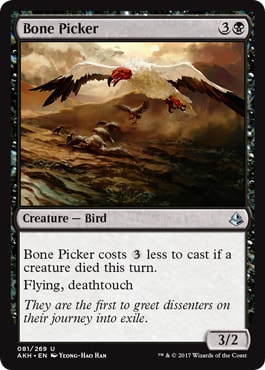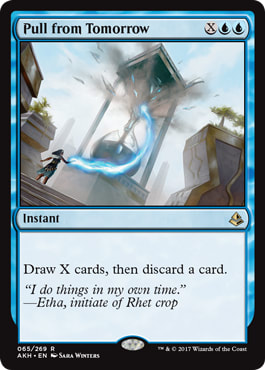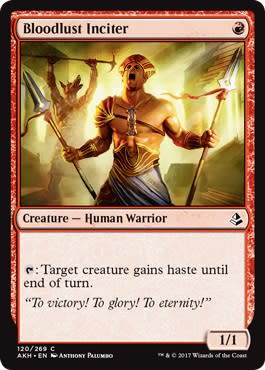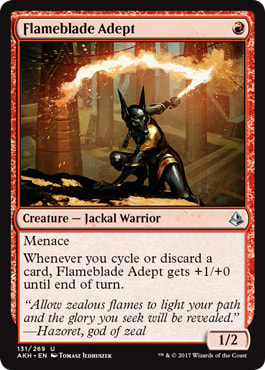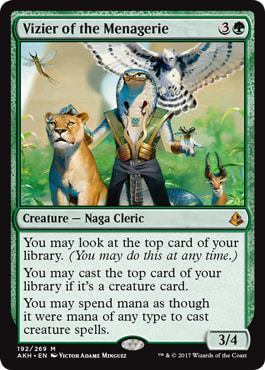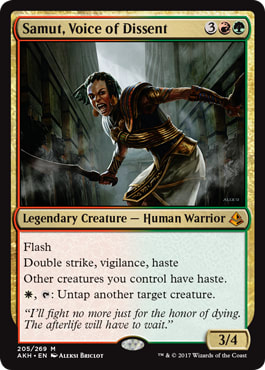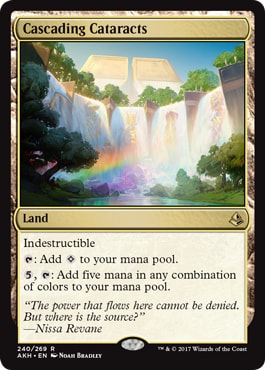Welcome to Part 2 of my Amonkhet Cube Review!
Of note: Although this set review has been released after the prerelease, please note that these are based on actual play in my Cube and not merely outsourced to playing at the prerelease or Standard constructed events. If I'm saying a card has been working well based on my experience, it's based on actual experience from trying them out in my Cube and finding the cards actually have been working well in my Cube.
My 465-powered Cube list is the list used for context and despite false dichotomies about how power can warp a Cube, your Cube experience with these cards likely will mirror mine.
As usual, I'll be breaking these down by mechanic before talking about the miscellaneous cards.
Planeswalkers
Gideon of the Trials is the worst Gideon* for Cube, but that's a fair bar considering that they're all amazing Cube cards.
One area where the previous Gideons really shine in their ability to take over the game when they resolve, either generating a token army over time, threatening to bash the opponent over the head quickly, or defend other Planeswalkers. Like the other Gideons, Gideon of the Trials can't build up to an ultimate, with the closest being Gideon, Ally of Zendikar's emblem, which can be reached with his starting loyalty.
Gideon of the Trials has some of these features, as he attacks for 4 and can defend other things well. I found that he tended to play a few roles:
- If there was only one other threat on the board, he was able to neutralize that threat a la Kiora, the Crashing Wave.
- If the opponent had no threats or threats that couldn't crack back and kill Gideon, he became a 4/4.
I found that his emblem ability was mostly unused unless Gideon could be defended very well, either with a great board state or a grip of countermagic. He'd usually kill the opponent in those scenarios, but a ham sandwich would have as well.
Like Kiora, I found that if he was facing multiple threats, like a 3/3 and a 2/2, he mostly acted like a Maze of Ith, which was still fine, but needed help at that stage of the game to turn things around. Like Maze of Ith, he typically encouraged over extending but sometimes it didn't require a lot of work to overwhelm him.
This may sound like a lot of marks against him; and, if you’re limiting Planeswalkers in your Cube, it may be hard for him to find a home. However, he's still a very good White card for Cube decks as a multifaceted beater.
Liliana, Death's Majesty was a card that ended up also performing better than she looked. It felt like there was some more attention paid toward her as she's a Black 5-drop and, for the most part, there aren't a lot of them aside from Shriekmaw, but she has performed well in Black midrange and control decks.
When looking at the mana cost of token-generating Planeswalkers which have seen Cube play, the costs were as follows:
3 — Daretti, Ingenious Iconoclast, Nissa, Voice of Zendikar
4 — Garruk Relentless, Garruk Wildspeaker, Elspeth, Knight-Errant, Gideon, Ally of Zendikar
5 — Garruk, Primal Hunter, Freyalise, Llanowar's Fury, Nahiri, the Lithomancer, Elspeth Tirel
6+ — Elspeth, Sun's Champion, Chandra, Flamecaller, Garruk, Apex Predator
Liliana, Death's Majesty falls between Garruk, Primal Hunter and the others as she generates 2/2s with a +1 activation, where as the non-Garruk ones generate 1/1s. The +1 ended up working out really well at both defending her and putting things into the graveyard to target with her -3 ability. I never really found that her milling was a drawback and found a good number of times where she just happened to flip over something like a Wurmcoil Engine, a Titan or some other giant threat and it put the opponent in an awkward situation where they had to kill Liliana ASAP or have to deal with that threat and possibly some more.
There's an argument that she's a bad Zombify, but that misses the mark as a pretty myopic form of card evaluation that only evaluates one part of the card without the overall package and even discounts synergies. Is Liliana of the Veil a “bad Cruel Edict,” Nissa, Vital Force a “bad Nature's Spiral” or Elspeth, Sun's Champion a “bad Retribution of the Meek?” Of course not.
Aggressive decks aren't really in the market for her because, while she does generate a 2/2 army over time, she is a bit slow. She most likely will just Zombify something small. That said, I've still found her great for other Black decks in Cube.
Nissa, Steward of Elements — Simic finds itself in a similar situation to where Izzet was years ago, as its multicolored cards were all generally solid and would see play in decks that were in those colors, but people would rarely get pulled in that direction because of something like a Mystic Snake or an Electrolyze (and it didn't help that Izzet's cards mostly did the same thing — some form of direct damage with card advantage tacked on.) This ended up changing through cards like Dack Fayden, Dack's Duplicate, and Saheeli Rai broke the mold of Izzet value burn cards and became the upper tier of Izzet cards.
Edric, Spymaster of Trest aside, there aren't really any cards that pull people into going Simic — cards like Mystic Snake, Shardless Agent, Trygon Predator, and Kiora, the Crashing Wave are all fine and dandy but none seemed to match the power level of Edric.
I talked in the Pauper and Peasant review of Modern Masters 2017 of how cards like Slime Molding were an example of an X card which wasn't really good — as Slime Molding wasn't really good at any point on the mana curve and didn't really represent flexibility very well. Some X-spells like Bonfire of the Damned and Entreat the Angels certainly do while cast via miracle but are generally more “fine” when hardcast and wouldn't be Cube-able without the ability to miracle them.
However, a card like Unexpectedly Absent has a pretty stellar “base mode” of ![]()
![]() for a non-land hitting instant Time Ebb with some excellent other potential to tuck something into the stone age. It never caught on in Legacy like development anticipated, but it still has performed well in Cube.
for a non-land hitting instant Time Ebb with some excellent other potential to tuck something into the stone age. It never caught on in Legacy like development anticipated, but it still has performed well in Cube.
Nissa, Steward of Elements's general modes have either been:
- Casting her for


 , scrying 2 and alternating scrying and using her for 0, generally drawing a card.
, scrying 2 and alternating scrying and using her for 0, generally drawing a card. - Casting her for


 , going ultimate and hitting the opponent for 10.
, going ultimate and hitting the opponent for 10. - Casting her for something like


 or
or 

 , so that she either gets activated for 0 and hits something or scrys, generating a ton of value over time.
, so that she either gets activated for 0 and hits something or scrys, generating a ton of value over time.
Being able to either ultimate and hit someone for 10 or threatening to do so are angles that don't tend to get represented in Simic decks in Cube since there aren't a lot of “direct damage” cards in those colors (aside from Psionic Blast, Ugin, the Spirit Dragon, and Walking Ballista).
That said, she doesn't do much when behind as she can't protect herself. If she has enough counters to get a creature to defend her, that may not even be enough.
But the same could be said of some of great walkers — Koth of the Hammer, Jace Beleren, Jace, Telepath Unbound, Saheeli Rai and, in most scenarios, Dack Fayden.
There's a lot of subtle play and flexibility to the new Nissa and I've been impressed with her thus far. She's a pretty easy inclusion especially due to the makeup of Simic cards currently.
Regal Caracal has been compared to Cloudgoat Ranger but it's closer to Captain of the Watch (Catptain?) as a tribal lord that creates an army in a can. It gums up the ground and is somewhat vulnerable to removal, but will leave something behind should it be removed.
It's not a “bad” card, per se, but Cubes will have a hard time including it when considering Angel of Sanctions, Angel of Invention are (arguably?) better than it and other White 5-drops like Baneslayer Angel, Archangel Avacyn, Reveillark, (Gideon Jura, if counting him as a creature) put a lot of pressure on the White 5-drops slot. That makes it a hard sell.
As Foretold has been receiving a lot of attention for combining with the 0-mana cost suspend cards like Ancestral Vision and Restore Balance. It turns out it's extremely good in Cube even without caring about those cards.
Matt Kranstuber, fellow cube confidant, got me on board with this for Cube after having good vibes about it.
As Foretold can be easy to dismiss since it “is a bad topdeck” but lots of great Cube cards can be — Sulfuric Vortex is worthless when behind and equipment/vehicles with nothing to back them up are bad topdecks as well. I found that As Foretold gets cast and only really needs a few turns to make up for its return on mana investment and usually far exceeds it. Blue decks tend to run a gamut of counterspells and I found that once As Foretold got to 2 counters, being able to counter things for free was difficult to work past (as it works on each turn.)
Check out this 3-0 deck which had As Foretold.
3-0 As Foretold List ? Cube | Usman Jamil
- Creatures (8)
- 1 Glorybringer
- 1 Kiki-Jiki, Mirror Breaker
- 1 Monastery Swiftspear
- 1 Mulldrifter
- 1 Porcelain Legionnaire
- 1 Sower of Temptation
- 1 Venser, Shaper Savant
- 1 Zealous Conscripts
- Planeswalkers (2)
- 1 Ajani Vengeant
- 1 Jace, the Mind Sculptor
- Instants (9)
- 1 Censor
- 1 Commit // Memory
- 1 Counterspell
- 1 Cryptic Command
- 1 Daze
- 1 Forbid
- 1 Lightning Bolt
- 1 Pull from Tomorrow
- 1 Searing Spear
- Sorceries (4)
- 1 Baral's Expertise
- 1 Chain Lightning
- 1 Firebolt
- 1 Gitaxian Probe
- Enchantments (1)
- 1 As Foretold
- Artifacts (2)
- 1 Pyramid of the Pantheon
- 1 Sensei's Divining Top
- Lands (14)
- 1 Plains
- 4 Mountain
- 5 Island
- 1 Flooded Strand
- 1 Strip Mine
- 1 Volcanic Island
- 1 Wandering Fumarole
Sometimes it's easy to fall for absolutes and think of what a card can do and get disappointed when the card doesn't reach that potential (think of how Primeval Titan was dismissed for Cube since the best land that it could get, Library of Alexandria, was awful on turn six and other mana fixing lands weren't that great on turn six.) This isn't really a deck that's specifically built around As Foretold, but a meat and potatoes Izzet control deck (splashing for Ajani Vengeant, although I'm honestly not sure what Monastery Swiftspear and Porcelain Legionnaire are doing) and doesn't have anything like Ancestral Vision to be broken with it, just casting spells for free. While Matt said that it's the best non-creature 3-mana card, and I'm not sure that I'd agree, it's pretty high up there.
Bone Picker, isn't as good as it may look since it's harder to get morbid going in the early stages of the game and can be atrocious if the opponent isn't packing a lot of creatures. If you've played Tragic Slip and Brimstone Volley, think of how they played out in your Cube and Bone Picker is about the same — it can go morbid much easier in a deck that has ways to sacrifice creatures (similar to Bontu) but in other decks, it generally required too much setup for not enough power.
Pull from Tomorrow was a big-mana draw card that impressed me for Cube.
I've seen comparisons of Pull from Tomorrow to Sphinx's Revelation, a card that was dismissed in many formats for being too clunky in the early stages of the game, dismissing how powerful it was in the later stages of the game to pull you ahead once you've 1-for-1ed your opponent into oblivion.
Stroke of Genius is another comparison point as an instant-speed draw spell and it may be the most appropriate comparison; but, it operates under the impression that casting Stroke of Genius and Pull for Tomorrow are the same since you're up the same number of cards. I found that this was a false equivalency since, when Pull from Tomorrow was cast, the decks that wanted it almost always had something to discard (like a land) and it dug a card deeper, making it perform much better than Stroke of Genius (kill condition aside, but even in those cases, it's clunky.)
I found that in Blue control decks, it generally was cast for X=3 at the lowest amount (unless it was a dire situation.) There's a temptation to say it's a bad card because it's worse than Jace's Ingenuity at 5, but this discounts how powerful its flexibility is, as casting it for 5+ cards generally meant that the caster won the game if it resolved, as, like with Sphinx's Revelation, it rewarded the caster for trading 1-for-1 and then slamming the door by drawing a ton of cards at instant speed.
The amount of good instant speed cards has waned over the years, but we've gotten some good ones like Dig through Time. This is another good one.
Dread Wanderer is yet another 2/1 for 1 in Black which has a recursion ability. I found that it wasn't hard to get it go to “heckbent” in Black aggro decks; and, like other Black recursive creatures, it give Black aggro a nice identity by discouraging trades since the creatures can come back. It's a pretty easy add if you're pushing Black aggro and a pretty easy non-add if you aren't, since non-aggro decks don't want to play this.
Manglehorn is yet another riff on Uktabi Orangutan with upside by making mana rocks and artifact creatures enter the battlefield tapped, as well as letting you cast it when you have an artifact out without 2-for-1ing yourself due to its may trigger.
Most Cubes should have no problem including these cards; and, depending on how you want to craft your Cube's archetypes' representation and balance, may end up replacing some of the old guard. However, please consider your Cube's holistic needs rather than just taking the easy way out.
Liliana's Mastery isn't as much of a tribal card in Cube as a general midrange card that creates a couple of virtual 3/3s, acting as an archetypal counterpoint to Sarcomancy. Black 5-drops have been historically weak, as Shriekmaw ruled the roost with little competition for a long time; and, for a while, only Custodi Lich was the only real contender to that crown. Like Sarcomancy, there are benefits from having cards that can bounce your own permanents or those that care about multiple permanents to sacrifice (Smokestack) but it's still middle-of-the pack for Cubes that aren't going out of their way to enable zombie decks.
Supernatural Stamina is one of the better Undying Evil types of cards that are a combat trick and a way to protect a creature. The prevalence of mass removal and spot removal make it so that these types of cards tend to have a narrow timing window to be good. It giving +2/+0 is nice to give it more use as even in Pauper Cube, I found that Undying Evil could be a stone blank at times but limited timing windows make this a hard include for many Cubes.
Bloodlust Inciter is a card that, at first, I didn't give much thought to, but turns out that Kenny Mayer called it again and it turns out that it's quite good.
I had drafted an undefeated deck where I had to deal broker a Tinker away and was offered Fulminator Mage and Bloodlust Inciter as relevant options. I took the Inciter somewhat joking that I wanted to try out a new card but mostly because the deck really needed another 1-drop.
3-0 Bloodlust Inciter List ? Cube | Usman Jamil
- Creatures (11)
- 1 Abbot of Keral Keep
- 1 Bloodlust Inciter
- 1 Deal Broker
- 1 Glorybringer
- 1 Goblin Rabblemaster
- 1 Grim Lavamancer
- 1 Harsh Mentor
- 1 Kari Zev, Skyship Raider
- 1 Phyrexian Metamorph
- 1 Spellskite
- 1 Stoneforge Mystic
- Planeswalkers (2)
- 1 Chandra, Flamecaller
- 1 Chandra, Torch of Defiance
- Instants (3)
- 1 Burst Lightning
- 1 Fireblast
- 1 Path to Exile
- Sorceries (2)
- 1 Firebolt
- 1 Kari Zev's Expertise
- Enchantments (1)
- 1 Banishing Light
- Artifacts (5)
- 1 Batterskull
- 1 Mox Ruby
- 1 Shrine of Burning Rage
- 1 Sword of Light and Shadow
- 1 Umezawa's Jitte
- Lands (16)
- 10 Mountain
- 4 Plains
- 1 Blinkmoth Nexus
- 1 Wooded Foothills
It only took one match to realize that taking Bloodlust Inciter was absolutely correct and far exceeded my lukewarm impressions, as it was impressive with the damage throughput that it provided, giving creatures like Kari Zev and Abbot of Keral Keep haste. I found that he more than made up for the lacking of a second power as the damage he provided was excellent.
It's true that Red aggro 4-drops and some Red aggro 5-drops already have haste, but Bloodlust Inciter isn't really for those creatures anyway, he's more for generating a lot of damage output.
I found that Bloodlust Inciter really isn't for non-aggro decks unless they have a lot of creatures that benefit from attacking — more along the lines of the titans, Wurmcoil Engine than Hornet Queen and Mulldrifter.
It's hard to say where the line in the sand is for how many 1-drops you should have to support Red aggressive strategies but Bloodlust Inciter complements them very well.
Bloodrage Brawler and Harsh Mentor: Red 2-drops nowadays are to the point where 3/2s for 2 like Thriving Grubs no longer really excite Cube designers anymore (I find people generally tend to lean harder on 2-drops than 1-drops, even though 1-drops are more important for Red aggro decks) since we've been getting better 1-drops and the introduction of some more 2-drops recently.
Bloodrage Brawler and Harsh Mentor represent this set's inclusions. Let's first go over Harsh Mentor.
The Philosophy of Fire, talks about treating cards as a resource and cards like Eidolon of the Great Revel that punish people on a specific axis for just “just playing Magic” as it wasn't hard for those decks to take 4-6 damage even if people associate those decks with late game spells. It's harder for Harsh Mentor to hit people by playing that same way, although, as Mark Oberdries pointed out, sometimes it's hard to really see how much a card that punishes people can impact a game. Even if it's not directly impacting the game through damage, I found that sometimes the threat of taking damage makes the opponent choose less suitable paths and it's already been working well in Red aggro decks in my Cube.
Bloodrage Brawler does look like it can tussle better with other creatures, but it requiring a discard is a real cost that makes cards play worse. Even if aggro decks don't mind pitching a card when they're hellbent or just holding a land, typically that ends up being a real cost in the early game (a.k.a. when these kinds of cards want to be played out).
By Force has a hard time making it into Cubes as the market really isn't there for a mass artifact removal spell. It's better than cards like Shattering Spree as it's easier for most decks to cast, but generally cards that solely kill artifacts need to offer some upside to be played in Cube. Unfortunately, this doesn't.
Flameblade Adept is a poor card for Cube, mainly because the payoffs to make it work aren't there in this format. Let's say, for the sake of argument, that a deck with Flameblade Adept would need 7 cards to make it consistently deal enough damage to perform well in a Red aggro deck. Is that something that's really even realistic? What would the deck look like — a Rakdos deck that goes deep on symmetrical discard a la Liliana of the Veil? Izzet aggro with a lot of looters? Considering how even in Blue, I never saw Curator of Mysteries' cycle/discard trigger happen, there's likely not a home for Flameblade Adept, especially when considering that it isn't really dealing more damage than the average 2/x for 1 or something like Goblin Glory Chaser.
Prowling Serpopard doesn't really have a home in Cube either, as it's a french vanilla creature but one that doesn't do enough against non-Blue decks since it’s a Trained Armodon with 1 extra power. It's difficult to say if it's even better overall than something like Great Sable Stag, but the days of running hoser types of cards that specifically call out other colors are mostly over.
There's also a pretty big fail at not saying “Hiss” as the flavor text. Maybe it was just too easy.
Soul-Scar Mage has some comparison to Monastery Swiftspear as an obvious comparison as a 1-drop 1/2 with prowess. Swiftspear's haste allowed her to act somewhat like a burn spell, but I more often found that if she was attacking with haste, she typically just attacked for 1 or 2, so when playing with Soul-Scar Mage in Red aggro, I evaluated it with direct comparison to Swiftspear and found that it wasn't losing out on a lot of damage.
Soul-Scar Mage's special ability obviously combines with burn and can help to mow down larger creatures so that they can trade down — and even the threat of casting a spell can make blocking awkward. I found that in Red aggro decks, the ability was somewhat relevant, more so if it was on a source that could deal damage multiple times like the Chandra Planeswalkers, Grim Lavamancer, Cursed Scroll, Firebolt, and Staggershock, so that blocking situations end up terribly for the opponent. It performed well without a glut of burn; and, while it's not in the ranks of cards like Zurgo Bellstriker, Soul-Scar Mage fills the ranks of other virtual 2-drops as a great card for Red aggro decks.
Vizier of the Menagerie was one of the cards that disappointed me the most for Cube from Amonkhet.
It looks like it compares to Oracle of Mul Daya and could potentially snowball easier, but found that its lack of immediate impact when cast at four mana and the amount of work required to really get value out of its “cast off the top” trigger made it suffer power-wise. I found that it was actually easier to snowball with Oracle of Mul Daya than Vizier; and, although it sports better combat stats and allows creatures to be cast with any color of mana, I found that these factors didn't really matter and overall it didn't give enough bang for the buck. Even considering how relatively weak Green 4-drops are, it was still mediocre.
Samut, Voice of Dissent — Let's be honest, even if with her White activation cost this is a Gruul card. She was always played in Gruul decks without access to White mana, which makes sense as it's easily the weakest part of the card.
Although she's a giant bundle of keywords, her primary role is as a 6-power “big dumb beater” with haste and being able to block (although that wasn't really that relevant.)
Haste and Flash aren't seen on the same card outside of weirdos like Raging Kavu, Hypersonic Dragon, and Izzet Staticaster, but it offers flexibility by letting her be a huge Ambush Viper. I found that didn't happen unless she was picking a fight against a control player's countermagic suite or removal spells. I did find that there were instances where she was cast EOT, then cast something else on the following turn, which turned the game around and the fears of her just dying to a removal spell, putting the brakes on the other creature didn't really happen that often.
Since she's a Gruul card, she occupies space in being a nice tool for ramp spells as a Fires of Yavimaya style card which accelerates other creatures while being fine on her own as well as being a servicable aggro curve topper, although that didn't happen and found while she was worse than Bloodbraid Elf and likely Dragonlord Atarka, Samut sat alongside them well.
Pyramid of the Pantheon ended up being a pretty solid (but not absurd) mana artifact. It played somewhat similarly to Gilded Lotus, not because of tapping for 3 mana, but because that decks that use it well are the decks that can effectively use the mana when it's used (having 1-mana and 1X spells, but instants work best to use it at end of turn.) Somewhat like Gilded Lotus, where it rewards decks that can effectively utilize the mana (going from 2 > 1), much like how Gilded Lotus rewards decks that can play cards after playing Gilded Lotus (so they're not going back a beat.) However, it's hard for it to compete with the glut of mana rocks in Cube (even if not using signets) but it's another tool for those decks to use.
Throne of the God-Pharaoh is currently underrated as a tool for aggro decks.
I've found it to be a nice source of damage, especially with evasive creatures and if the deck can burn blockers out of the way for non-evasive creatures to attack. Much like As Foretold, there's some arguments about how it can be a bad topdeck when you have no creatures, especially since these kinds of cards (Sulfuric Vortex and other “big burn” spells like Fireblast and Fiery Confluence) are best to close out the game once the opponent is at a low life total. If the opponent sees it coming, they can just cook your potential attackers. However, like the Philosophy of Fire dictates, I found it was better as a general source of damage, representing typically about 4-6 damage over the course of the game and hardly was a “win more” card.
There's use for it in other decks like Green ramp with mana elves and in conjunction with Opposition, but I never really saw that come together. I did see an interaction where it turned Smuggler's Copter into a Kyren Negotiations and ended the game after, an interaction which development likely had in mind when developing the Throne.
You may be asking why I like Throne of the God-Pharaoh, but not Combat Celebrant or saboteurs without evasion, as Throne, for the most part, turns creatures into saboteurs. That may be true, but it doesn’t take a few things into consideration. Throne of the God-Pharaoh works well against walls which stop attackers and the damage to cost ratio is high enough to justify playing it in aggressive decks despite possible feel-bads of topdecking it with no creatures.
While Pyramid may have a tough time competing with the myriad of mana rocks, there aren't really a lot of aggressive artifacts (there are some, but nowhere near as many as generic mana rocks and giant robots) — Throne is a pretty easy inclusion to bolster aggro decks.
Cascading Cataracts is too clunky and was intentionally designed to be weak. Oh well, move over Crystal Quarry for those non-existent Cubes that are playing it!
Thanks for reading, I hope you've enjoyed this deep dive into Amonkhet for Cube!
My blog, featuring my Pauper and powered Cube lists.
Cube podcast, The Third Power, that Anthony Avitollo and I host.
Find me on Twitter @UsmanTheRad
*Not counting Gideon, Champion of Justice since that card is awful.
















